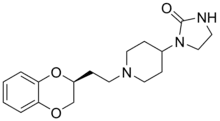 | |
| Clinical data | |
|---|---|
| ATC code |
|
| Identifiers | |
| |
| CAS Number | |
| PubChem CID | |
| ChemSpider | |
| UNII | |
| ChEMBL | |
| CompTox Dashboard (EPA) | |
| Chemical and physical data | |
| Formula | C18H25N3O3 |
| Molar mass | 331.416 g·mol−1 |
| 3D model (JSmol) | |
| |
| |
| | |
Azaloxan (CGS-7135A) is a drug which was patented as an antidepressant by Ciba-Geigy in the early 1980s, but was never marketed.[1]
Synthesis
Thymoleptic described as a “psychostimulant” according to patent title.

The halogenation of allyl cyanide [109-75-1] (1) with bromine gives 3,4-dibromobutyronitrile [25109-74-4] (2). This is further reacted with catechol [120-80-9] (3) to give the 1,4-benzodioxan-2-yl-acetonitrile [18505-91-4] (4). Acid catalyzed hydrolysis of the nitrile to the acid gives 1,4-benzodioxan-2-yl-acetic acid [18505-92-5] (5). The reduction of this to alcohol with sodium bis(2-methoxyethoxy)aluminium hydride gives 2-(1,4-benzodioxan-2-yl)ethanol [62590-71-0] (6). The tosylation of this intermediate gives CID:12850582 (7). The synthesis concludes with an SN-2 displacement reaction with 1-(4-piperidinyl)-2-imidazolidinone [52210-86-3] (8) completing the synthesis of Azaloxan (9).
See also
References
- ↑ Triggle DJ (1997). Dictionary of pharmacological agents. London: Chapman & Hall. ISBN 0-412-46630-9.
- ↑ Charles F. Huebner, U.S. Patent 4,329,348 (1982 to Ciba-Geigy Corporation).